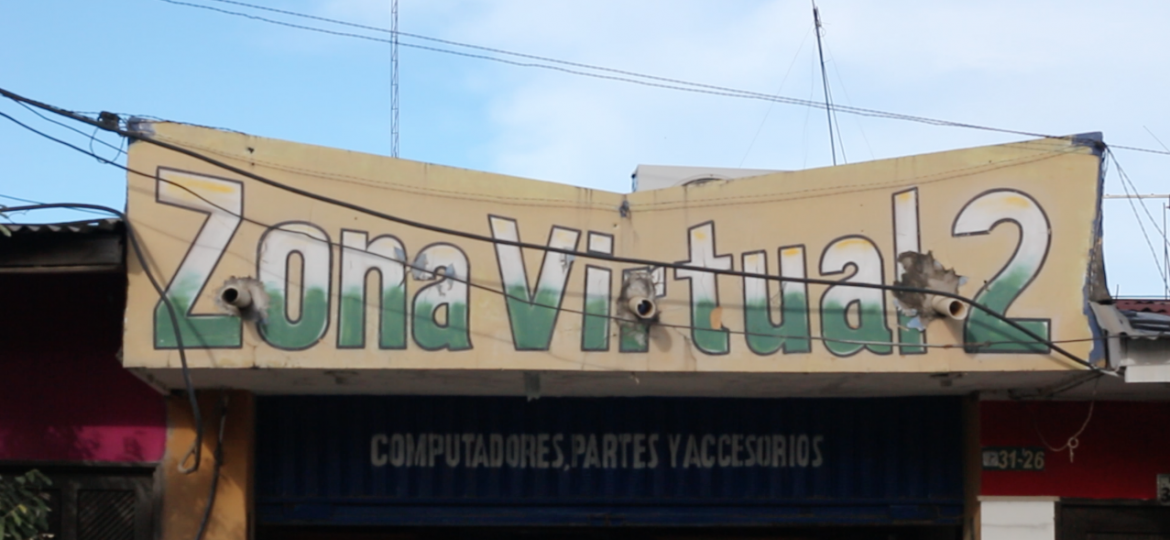
The terms used to describe historical periods in our society tend to reflect a skewed and linear notion of the end goal of development. The “digital” or “information” era is no exception, as it refers to the technological revolution that has led to some of the most opulent markets in history, based on the exchange, commodification, and industrialization of digital information. Visual arts are caught in this historical hurricane, as many artists use and/or respond to these technological updates. Regardless of how critical artistic projects can be of the phenomena, the field known as “digital arts” has exponentially grown in universities, galleries, museums and in artists’ own definition of their work.
The discourse on the digital era of most industries and governments in the global north, is based on notions of cosmopolitan openness, increased and enhanced transnational connectivity, and a made-easy urban life, with public and private services reduced to the screen of a phone. However, as these concepts are used universally, it is important to understand the difficulties, challenges, and possibilities of digital art and culture in the global south. A critical view of these historical times can open up the doors for digital language to become a useful political, ideological, and aesthetic tool for the geopolitical spaces on the receiving end of the spectrum.
The material conditions of the digital revolution
The Internet World Stats provides a grim picture for the advancement of digital net culture in the African continent, revealing that there is only a 27.7% penetration rate of the Internet into the lives of African citizens, and they represent only a 9.3% of all Internet users worldwide. Similarly, the Americas represent 18.9% of all Internet users around the globe, a number significantly increased by the inclusion of North America in the statistics.
This article doesn’t pretend to argue that, according to these numbers, there should be more devices and technology brought to the global south. In fact, that is the discourse of most governments and companies in developing nations, who promise computers and tablets for the poor in order to foreclose discussions about the origins and usage of these technologies. Even if Latin America and Africa were plagued by computers, smartphones, tablets, and whatever other gadget you could imagine, these products end up generating more problems and waste than solution to the communities they penetrate. The promise of bringing new technologies into the global south usually disguises a continued process of colonization and dependency on foreign market dynamics.
The market of digital goods and of digital information emerges from colonial economic dynamics that have historically dominated the relationship between the north and the south. Most of the metals needed for the digital economy, such as cobalt, are extracted from large mines in poorer nations, rich in minerals and mines. One of the biggest cobalt mines is in the Democratic Republic of Congo, where child labor is rampant. These precious metals are exported at unregulated prices from several southern countries, manufactured into devices by the north, and sold as fully packaged digital goods back to the south.
These metals are highly toxic, not only putting in danger the lives of many workers, but also contaminating the ground through landfills where these metals seep back into the ground. According to the The Guardian, the Interpol says that it is a common practice for companies and countries in the global north to send digital hardware that could be reused or refurbished to poorer countries. However, the article argues that many countries in Europe export discarded goods to African and Asian countries under false pretenses, mainly in order to avoid the costs associated with the recycling process. The European Environment Agency “estimates that between 250,000 tonnes and 1.3m tonnes of used electrical products are shipped out of the EU every year, mostly to west Africa and Asia.”
Similarly, the United States “discarded 258.2m computers, monitors, TVs and mobile phones in 2010, of which only 66% was recycled. Nearly 120m mobile phones were collected, most of which were shipped to Hong Kong, Latin America and the Caribbean.” When the millions of computers that arrive to the global south become obsolete (according to the United Nations Environment Programme it was 183 million in 2004), they leave behind dangerous materials such as lead and mercury, contaminating and polluting the environment of these countries. It is a complete business for the countries in the north; they acquire the cheap materials, produce and sell the goods at high prices, and don’t have to deal with the waste they produce.
Africa and Latin America experience digital culture in its material conditions, as Europe and North America tend to experience it in its intangible form. What is the cosmopolitan and open culture of the web for the north, is usually translated into e-waste and exploitation in the south.
Understanding Digital Art as a World Phenomenon
If digital arts are visual arts done with a digital medium, then the question of the medium itself becomes crucial in our analysis of this artistic practice in the global south. The materiality of the medium was addressed previously, yet it is also important to discuss that most of the platforms that are used in order to produce digital images, sound, and video, are created and distributed by companies in the global north. Not only do these companies cash in the gains of their sales, but they also sell them in their own currency making them significantly more inaccessible to the general public in countries in the south, most of them with devalued currencies and inflated economies.
This becomes relevant in order to understand the codes of language introduced by these technologies, which cannot be separated from the spaces from which they emerge. Digital culture allows for major access to images and sounds from other places, other cultures, other ideologies. Even though this has been crucial for the global south in terms of expanding transatlantic networks, not all of them stem from a necessity to decolonize, or at least to rethink the spaces of exchange. In most cases, the use of digital platforms tends to homogenize cultures, since the platforms offered to present ourselves digitally (facebook, twitter, instagram), are all associated with a particular aesthetic and way of knowing, as much as these companies try to be as internationalized as possible.
In the digital arts there is a similar condition, where the categories of “net.art” or of “post-internet art”, explain the shifts and uses of digital mediums to expand the notion of artistic practice. These categories make sense as a linear, almost inevitable result of the conceptual art movements that defined the art of the global north in the 60s and 70s.
It is important to account for digital technology not as a universal phenomenon, which is what tends to happen with Facebook, but rather as a context-dependent one. Technology doesn’t signify the same thing everywhere; its usages, necessities, and opportunities depend on the spaces it inhabits. Similar to the decolonial discourse on language and representation, discussed by important figures such as Léopold Sedar Senghor and Frantz Fanon, how can we arrive at decolonized and local languages of technology that apply to our own context?
Most of the artistic exchange between Africa and Latin America, especially digital arts, happens through platforms and institutions mediated by the global north. In part it is an inevitable financial condition, but it is also necessary to find the ways in which a south-south dialogue can happen. This dialogue becomes relevant since there are many experiences with technology and its codes that should be shared, where this transnational decolonized language could emerge. Understanding the material conditions of artistic practice as it is immersed in particular historical, economic, political and social spheres, is paramount in order to confront and delink from the colonial matrix of power.
Latin America coordination @Artbox Digital








